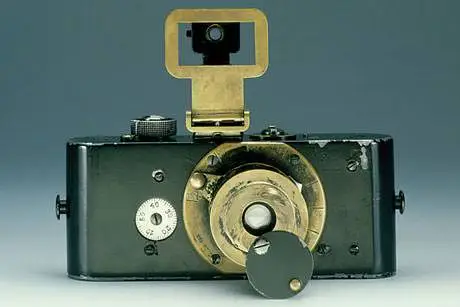The Ur-Leica
The Ur-Leica of 1914 represents a milestone in photographic history. It is the prototype for the first line of cameras that used film in the 24 x 36mm format. This format became the 35mm standard for photographic film and modern full-frame camera sensors – named after the width of 24 x 36mm film including the perforations. Using 35mm film instead of the earlier large photographic plates made it possible to produce cameras that were much smaller and more portable, and, thus, greatly facilitated outdoor photography and handheld shooting.

Oskar Barnack, a master technician at Ernst Leitz Optische Werke in Wetzlar/Germany, had the groundbreaking idea of doubling the width of then common 18x24mm cinema film and have it run horizontally in the Ur-Leica, rather than vertically as in cinema cameras of the time. He initially used the prototype camera to test the exposure for film projectors, but soon realized that the new design had potential as a self-standing stills camera. He completed his Ur-Leica in March 1914 as a small camera around a small negative that after enlargement, however, generated prints that showed less grain than the images from photographic plates. Also, the camera utilized the relatively inexpensive motion picture film, such that twelve pictures now could be taken for the costs of a single 5 x 7 plate. Better quality at lower costs from a more compact imaging tool was a sure recipe for commercial success. The latter came after the end of World War I, when Leitz started to sell the Leica I, which was based on the Ur-Leica.
As José Manuel Serrano Esparza points out in his comprehensive article on the Ur-Leica, Barnack's prototype camera already features a number of characteristics that carried over into future camera designs. These include the horizontally travelling 35mm film that can accommodate 36 exposures in one loading, an accessory-shoe on top of the camera to attach, for example, a framing viewfinder, and a large shutter release button surrounded by a knob that serves simultaneously to advance the film and to cock the shutter.

The Ur-Leica's shutter only supports two speeds, which are set by adjusting the tension on a spring: 1/20s and 1/40s. Moreover, the shutter cloth has a fixed slit that runs across the picture window. This means that the metallic black lens cover has to be put on the lens when cocking the shutter, so as to avoid that the film behind the shutter cloth is exposed to light. This inconvenience was addressed by Barnack in later version of the camera by adding a second shutter cloth that ensured the covered return of the slit to its original position.
In any case, the Ur-Leica represents a mechanical masterpiece that is relatively light and small. The camera's shoulder barely exceeds the height of a credit card. It is also a compact camera in the sense that it has an integrated lens, the retractable Mikro-Summar 42mm f/4.5. In the production Leica I, this lens was replaced by the optically superior Elmax 50mm f/3.5, which had been specifically designed for the camera by the chief optical engineer at Leitz, Max Berek. Berek and his team went on to develop a series of optical designs for 35mm cameras ("Elmar", "Hektor", "Summar", "Summitar") that established Leica as a leader in high quality camera lens production.

Oskar Barnack made three versions of the Ur-Leica. The first and third (without lens) are in the Leica museum in Wetzlar. Number two is lost. However, a number of copies exist. Before commercializing the Leica I, Leitz produced 31 pre-production 0-Series Leicas, which closely resemble the Ur-Leica. Twelve of these have been preserved. One such 0-Series camera was sold at a photographica auction in March 2018 for $2.97 million, making it the most expensive camera ever sold.
But there are also more accessible options for acquiring a piece of photographic history for your exposition cabinet. From the 1970s onwards, Leica produced sizeable batches of Ur-Leica replicas. Some of these are working models, others pure dummys. These replicas bear the inscription "Nachbildung der Ur-Leica" on the top plate. Working models nowadays trade for about $3,000-$4,000, while dummys can be found for a fourth of that price (see here on ebay).
Comparison with modern cameras
How does your camera look alongside the Ur-Leica? See a comparative side-by-side display with views from the front, the top, and the rear by entering your camera's name in the search box below.
Further Reading
The Ur-Leica was, of course, only the beginning of a great history of Leitz and Leica products. The brand's legacy is perhaps best illustrated through the Leica family tree that used to greet visitors at the company's exhibition center. It showcased all the cameras produced over time, with an important split in the 1960s into two branches: the M-series rangefinders and the R-series SLR-cameras. But it was arguably the extraordinary quality of its lenses that brought Leica fame. Both the M-catalog and the R-catalog were full of excellent to outstanding optics that, however, also commanded premium prices. In this context it is then not surprising that the world's most expensive camera lens is a Leica — the Apo-Telyt-R 5.6/1600mm.
You are here: Home » Camera Hub » Ur-Leica